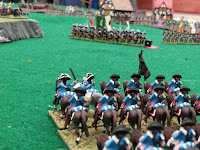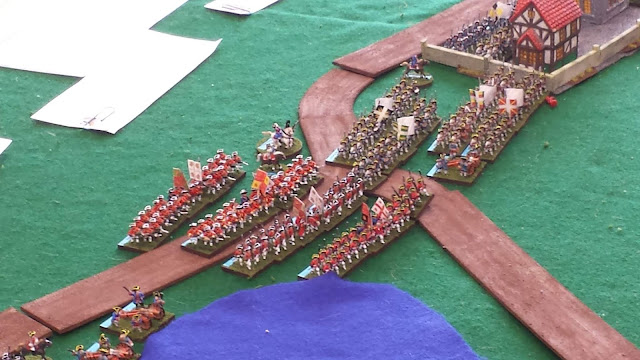After my last post on the hybrid Seven Years War rules we experimented with at the Hamilton Road Games Group, a few of the readers of this blog asked for information on the the rules we used. I can only say so much since we crashed and bashed two sets of SYW rules together and I don't want to violate any copyrights or anything like that.
{Please remember much of this is my opinion and may have no or little basis in your reality.}
 |
| "Chaos? Ain't no chaos here!" |
- Class 1 - Mercenaries, Freikorps, militia, and other less-than-reliable troops, including tribal warriors, such as Indian/First Nations warbands
- Class 2 - Regular infantry, artillery, and cavalry
- Class 3 - Elite troops - like grenadiers or most nations' cuirassiers
- Class 4 - Guard troops -- the rarest of the rare
Unit morale class reflects training and enthusiasm and determine how quickly certain maneuvers are accomplished. It is also taken into account when attempting to charge an enemy. Special training is reflected in BP by special rules. It's simpler to adjust the morale class of a unit and increase/reduce the unit's melee value. For example, Prussian hussars might be Class 2 "regulars" while Austrian hussars would be Class 3 "Elites." Melee values, taken wholesale from BP, might be best left alone, because morale classes also influence melees. ("Why reinvent the wheel?" I say.)
Weapons ranges are pretty tight in AoR, but that works just fine. As to artillery, we used only the medium artillery pieces. Others are possible, including siege guns, howitzers, and mortars, but remember to be flexible in this. Oh, yes, once a battery is unlimbered, it can only be moved by "prolonge" since the civilian contractor paid to move the guns has gone home to save his horse-flesh. Horse artillery, like that in the Prussian and Russian armies, or militarized transport like that in the Swedish army, can allow the guns to re-limber.
When determining combat, both ranged and hand-to-hand, we used the system from Black Powder. It's simpler, quite direct, and works fine. It takes into account large unit sized and morale classes by predetermining shooting and melee values. The system for melee can result in "hold your ground" for a continuing melee, a fall-back by the loser of the melee, or the complete destruction of the unit based on casualties and morale.
Once units begin to take casualties and might be "shaken", the player has to determine if his brigade or brigades are "broken." Eliminated units are counted up, permanently "shaken" regiments still on the table (actually these troops are routed) counting as 1/2 point, and if the number of units counted as casualties equals 25% of the original total, the top general has to roll on the AoR "Army withdrawal"table, using all the printed variables. The higher the percentage of losses, the tougher it is to stay in the battle. In our experimental game, this was problematic and a sticking point. Some players felt that some units were counted twice in a form of "double jeopardy." Andy and I discussed this and finally came to agree. So the ideas found above are a result of later consideration. This may still be a troublesome area, although I'm satisfied with it. Maybe more work needs to be done to get this right.
 Brigadier generals moving with their brigades can "heal" casualties in the regiments, reducing the accumulated number of casualties. (The final casualty cannot be removed.) BP requires that the general be attached to the regiment, but we said this could be done as long as the regiment in question was within the general's command radius (which is equal to his command value. For example, Frederick the Great has a value of 10 in BP, while certain Russian "Idiot generals" have a value of 6.) To heal, the player rolls less than or equal to the general's value on 2d6. He can do this to one regiment of his brigade in a turn
Brigadier generals moving with their brigades can "heal" casualties in the regiments, reducing the accumulated number of casualties. (The final casualty cannot be removed.) BP requires that the general be attached to the regiment, but we said this could be done as long as the regiment in question was within the general's command radius (which is equal to his command value. For example, Frederick the Great has a value of 10 in BP, while certain Russian "Idiot generals" have a value of 6.) To heal, the player rolls less than or equal to the general's value on 2d6. He can do this to one regiment of his brigade in a turnMaking up written brigade rosters is highly recommended. The general's name and command value is shown as well as each regiment's name, # of stands, morale class, shooting value, hand-to-hand value, "Stamina" (BP's morale value for use in knowing how many casualties a unit can take before it's shaken), and special notes - first fire, skirmisher, armoured cavalry, lancer, etc.
Now this is a "house rule" we use and I like it! Each brigade is assigned a playing card, red for one side, black for the other. Another set of identical cards is shuffled each turn and turned over one at a time. When your card comes up, your brigade moves. If the next card is one that cannot affect or be affected by your move, the other player in question may move. So if my card is turned up, and I move my cavalry brigade on my side's right flank and the next card activates a brigade on my opponent's right flank, that brigade may move as well because chances are there will be no interchange between them. However, if the next card activate the same army's brigade on my immediate left, he has to wait until I move. We could end up blocking each other's move, masking artillery batteries, and generally gumming up the works. This reflects the "fog of war" by the use of a quite simple mechanism.
I think this about covers it, but I'm betting there are still questions. With that in mind, I'm going to ask that longer questions be sent to me by e-mail (Grenzer7@aol.com) rather than the remarks left at the end of the blog. People deserve answers if they have questions. Let me know if you use these hybrid rules and if they are satisfactory. I'd like to know.
 |
| In the meantime, enjoy the view of these Austrian regiments... |
 |
| ...And a close-up of my wife's 15mm Bavarians... with hand painted flags. |





























